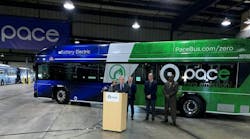Chicago RTA announces its plans for the future with 2025 regional operating budget and 2025-2029 Capital Program
The Chicago Regional Transportation Authority (RTA) Board of Directors has approved a new regional operating budget and the agency’s 2025-2029 Capital Program for metropolitan Chicago transit. The RTA notes that this will be the last one supported by federal COVID relief dollars before an operating fiscal cliff threatens the region’s transit system and puts current double-digit ridership growth at risk.
The 2025 budget includes $4.1 billion in operating expenses for northeastern Illinois’ transit system and a $9.4 billion 2025-2029 Regional Capital Program, a significant increase from previous capital programs, in large part due to federal and local funds for the Red Line Extension being programmed.
Despite the agency’s funding challenges, RTA notes that the region’s transit system is continuing to recover ridership, improve safety and security and deliver transit options riders need. The system provides more than 1.2 million rides per day, with special events and off-peak trips outpacing its pre-pandemic ridership numbers. Each agency has seen double-digit year-over-year growth, thanks to service expansions that would not have been possible without federal COVID relief dollars. In places where more service was added, riders have returned.
Looking ahead
2026 will be a critical pivot point when all COVID relief money will be spent and the agency will be put to the test. With absent sustainable funding for transit operations, the system falls off the fiscal cliff. Dramatic service cuts lead to immediate drops in ridership, making the budget gap larger and harder to solve. Instead, the agency will have to invest in its region, secure sustainable funding and introduce an increase in ridership with more service on the street.
RTA says the budget gap, which equals 20 percent of the region’s operations budget, translates to a 40 percent cut in service across all operators, which would be devastating for the region and would set off a downward spiral that would be nearly impossible to escape. On the other hand, increasing annual operating funding by at least $1.5 billion a year from current levels allows the transit agencies to expand and improve service -- for example, expanding Pace Pulse, increasing frequency across Metra lines and overhauling Chicago Transit Authority’s (CTA) bus service to work better for riders.
“In 2025, the region faces a critical decision for the future. Inaction will doom the Chicago region’s transit system to fall off the fiscal cliff and face cuts that make the system worse, or we can work together to achieve investment at levels that will unlock the region’s potential and meet our shared goals on equity, climate change and rider experience,” said RTA Executive Director Leanne Redden.
Chicago ranks fifth worldwide for worst congestion and a 40 percent reduction in service would add 366 million vehicle miles to the city’s already congested roads while costing the region $50 million a year in lost productivity, says RTA. This will ultimately affect residents, costing them more than $1,600 a year.
The RTA stresses that the state must act in the first half of 2025 to secure the future of the Chicago region’s transit system. If Illinois does not act by spring 2025, CTA, Metra and Pace will be forced to shift their focus from improvements and expansion to prepare for drastic service cuts and fare increases to balance their budgets, warns the RTA.
The 2025 budget also details the 2025-2029 Regional Capital Program of $9.4 billion, which is $3.5 billion larger than the 2024-2028 Capital Program, in large part due to funds for the Red Line Extension. Major investment from state and federal legislation has been a good first step, but the unmet need remains great. The 10-year regional capital funding need for all the priority projects in this budget totals $42.7 billion, but the vast majority of that need (more than 75 percent) remains unfunded.
This budget continues to implement the RTA Regional Transit Strategic Plan, Transit is the Answer, which was adopted in February 2023. That plan promoted a vision for safe, reliable, accessible public transportation that connects people to opportunity, advances equity and combats climate change. That vision and the plan’s principles of equity, stewardship and commitment to change, guide this budget and the work of the regional transit system going forward.
The 2025 budget will continue to make strides toward achieving the goals of the plan. For example, on the action item to “Accelerate the transition to a zero-emission regional transit system and prioritize communities burdened by poor air quality,” 82 percent of Pace’s 2025-2029 Capital Program will be used to replace diesel buses with electric buses. Between CTA and Pace, the regional capital program funds the purchase of nearly 300 electric buses. Major projects like the Red Line Extension will advance equity and ongoing work between the service boards and help to ensure the transit system is connecting people to opportunity.
The budget and capital program were released for public comment on Nov. 15 and the RTA presented to all six county boards in the region and held a virtual public hearing on Dec. 3, which followed similar hearings and comment periods by CTA, Metra and Pace for their respective budgets.





